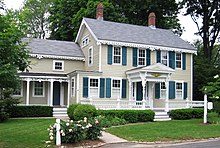Real estate
| Property law |
|---|
Part of the common law series |
Types |
|
Acquisition |
|
Estates in land |
|
Conveyancing |
|
Future use control |
|
Nonpossessory interest |
|
Related topics |
|
Other common law areas |
Higher category: Law and Common law |
Real estate is "property consisting of land and the buildings on it, along with its natural resources such as crops, minerals or water; immovable property of this nature; an interest vested in this (also) an item of real property, (more generally) buildings or housing in general. Also: the business of real estate; the profession of buying, selling, or renting land, buildings, or housing."[1]
It is a legal term used in jurisdictions whose legal system is derived from English common law, such as India, the United Kingdom, United States, Canada, Pakistan, Australia, and New Zealand.
Contents
1 Residential real estate
2 Sales and marketing
3 See also
4 References
5 External links
Residential real estate
Residential real estate may contain either a single family or multifamily structure that is available for occupation or for non-business purposes.[2]
Residences can be classified by if and how they are connected to neighbouring residences and land. Different types of housing tenure can be used for the same physical type. For example, connected residences might be owned by a single entity and leased out, or owned separately with an agreement covering the relationship between units and common areas and concerns.

Single-family detached house in Essex, Connecticut, USA.

A photograph of Townhouses in Victoria, Australia
- Major categories
- Attached / multi-unit dwellings
Apartment (American English) or Flat (British English) – An individual unit in a multi-unit building. The boundaries of the apartment are generally defined by a perimeter of locked or lockable doors. Often seen in multi-story apartment buildings.
Multi-family house – Often seen in multi-story detached buildings, where each floor is a separate apartment or unit.
Terraced house (a. k. a. townhouse or rowhouse) – A number of single or multi-unit buildings in a continuous row with shared walls and no intervening space.
Condominium (American English) – A building or complex, similar to apartments, owned by individuals. Common grounds and common areas within the complex are owned and shared jointly. In North America, there are townhouse or rowhouse style condominiums as well. The British equivalent is a block of flats.
Cooperative (a. k. a. co-op) – A type of multiple ownership in which the residents of a multi-unit housing complex own shares in the cooperative corporation that owns the property, giving each resident the right to occupy a specific apartment or unit.
Semi-detached dwellings
Duplex – Two units with one shared wall.
- Detached dwellings
Detached house or single-family detached house
- Portable dwellings
Mobile homes or residential caravans – A full-time residence that can be (although might not in practice be) movable on wheels.
Houseboats – A floating home
Tents – Usually temporary, with roof and walls consisting only of fabric-like material.
The size of an apartment or house can be described in square feet or meters. In the United States, this includes the area of "living space", excluding the garage and other non-living spaces. The "square meters" figure of a house in Europe may report the total area of the walls enclosing the home, thus including any attached garage and non-living spaces, which makes it important to inquire what kind of surface area definition has been used. It can be described more roughly by the number of rooms. A studio apartment has a single bedroom with no living room (possibly a separate kitchen). A one-bedroom apartment has a living or dining room separate from the bedroom. Two bedroom, three bedroom, and larger units are common. (A bedroom is a separate room intended for sleeping. It commonly contains a bed and, in newer dwelling units, a built-in closet for clothes storage.)
- Other categories
- Chawls
- Villas
- Havelis
The size of these is measured in Gaz (square yards), Quila, Marla, Beegha, and acre.
See List of house types for a complete listing of housing types and layouts, real estate trends for shifts in the market, and house or home for more general information.
Sales and marketing
It is common practice for an intermediary to provide real estate owners with dedicated sales and marketing support in exchange for commission. In North America, this intermediary is referred to as a real estate broker (or realtor), whilst in the United Kingdom, the intermediary would be referred to as an estate agent. In Australia the intermediary is referred to as a real estate agent or real estate representative or the agent.[3]
See also
|
|
|
References
^ "Real estate": Oxford English Dictionary online: Retrieved September 18, 2011
^ "Title 16. Conservation; Chapter 1. National Parks, Military Parks, Monuments, and Seashores; Minute Man National Historical Park". US Legal.
^ "Glossary of Terms". Real Estate Institute of Australia (REIA). Retrieved 25 March 2018.
External links
| Wikiquote has quotations related to: Real estate |
 The dictionary definition of real estate at Wiktionary
The dictionary definition of real estate at Wiktionary

 Clash Royale CLAN TAG#URR8PPP
Clash Royale CLAN TAG#URR8PPP